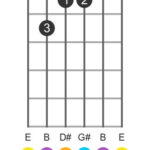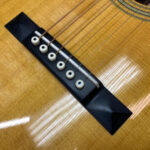For anyone starting their musical journey with the acoustic guitar, mastering the art of tuning is the very first step. Whether you’re strumming basic chords in your bedroom or aiming to play complex pieces, a guitar that’s perfectly in tune is non-negotiable. Knowing how to tune your acoustic guitar with a tuner is arguably the most essential skill a guitarist can learn, and thankfully, it’s a skill easily acquired within your first few days of playing.
This guide is designed to be your comprehensive resource for tuning your acoustic guitar effectively using a tuner. By the end of this article, you’ll not only understand how to tune but also the mechanics behind it, setting you firmly on the path to musical enjoyment.
Understanding How Guitar Tuning Works
Before diving into the practical steps, let’s briefly explore the physics of guitar tuning. Understanding the fundamentals will make the process more intuitive and less like rote memorization.
Guitar strings produce sound through vibration. These strings are held taut between two points on your guitar: the bridge on the body and the tuning pegs on the headstock. On a steel-string acoustic guitar, strings are typically anchored at the bridge with bridge pins and wound around the tuning posts at the headstock. Nylon-string guitars use a slightly different system where strings are tied at the bridge and then attached to tuning machines on the headstock.
The tuning pegs are the key to controlling string tension. Tension is directly related to pitch. Tightening a tuning peg increases the string’s tension, which in turn raises the pitch of the note it produces – we say the note becomes sharper. Conversely, loosening the peg reduces tension, lowering the pitch, making the note flatter.
Sound itself is a pressure wave traveling through the air. A tighter string vibrates more rapidly, creating sound waves that are closer together, resulting in a higher frequency and thus a higher pitch. Thicker strings, or strings with a larger gauge, vibrate more slowly because of their mass, leading to a lower pitch. This is why guitar strings vary in thickness from the thin high E string to the thick low E string.
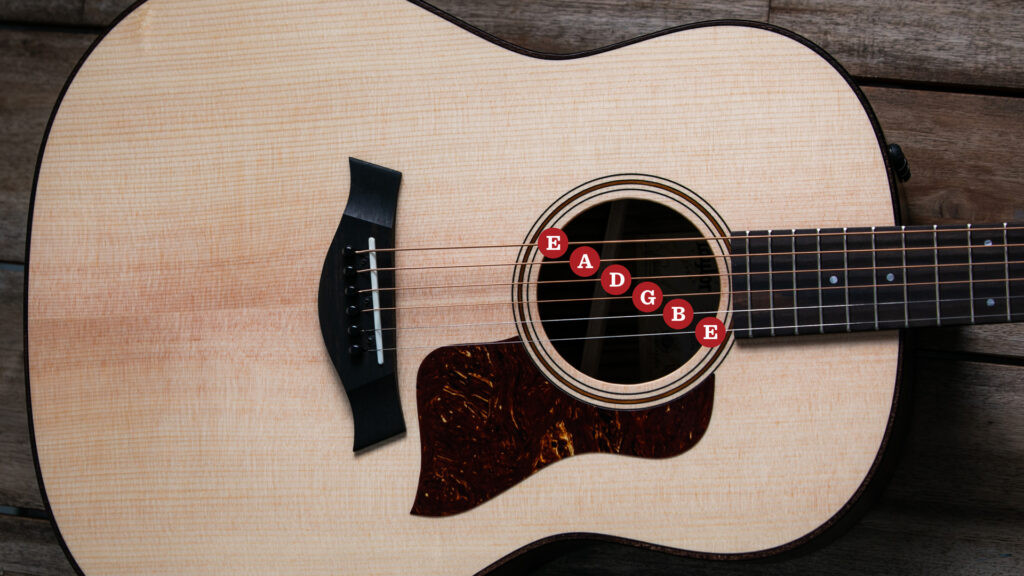 Diagram showing parts of an acoustic guitar related to tuning: headstock, tuning pegs, strings, bridge
Diagram showing parts of an acoustic guitar related to tuning: headstock, tuning pegs, strings, bridge
Acoustic Guitar Standard Tuning: EADGBE
The most common tuning for acoustic guitars is called “standard tuning.” It’s the foundation for a vast majority of popular music genres. In standard tuning, the open strings, from the thickest to thinnest, are tuned to the notes E, A, D, G, B, and E. Guitarists often use mnemonic devices to memorize this sequence. Here are a few popular ones:
- Eddie Ate Dynamite, Good Bye Eddie
- Elephants Are Darn Good Banana Eaters
- Eat All Day Get Big Easy
Guitar strings are also numbered, starting with the thickest string as the 6th string (low E), the next thickest as the 5th string (A), and so on, down to the thinnest string as the 1st string (high E).
When tuning, remember that turning the tuning peg away from you (clockwise on many guitars, but check your specific guitar) will generally tighten the string, raising the pitch. Turning the peg towards you (counter-clockwise) will loosen the string, lowering the pitch.
A crucial technique for stable tuning is to always tune up to pitch. If a string is sharp (too high), first loosen it below the correct pitch, then slowly tighten it until you reach the desired note. Tuning up to pitch helps to seat the string and reduces slippage in the tuning peg gears, which can cause your guitar to go out of tune quickly.
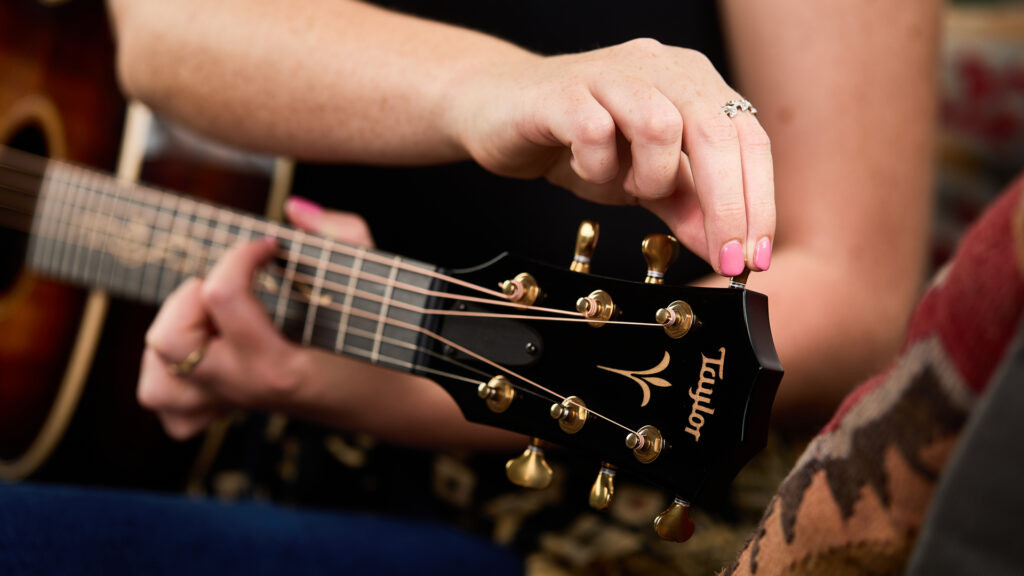 Close up of a hand tuning a guitar headstock with tuning pegs
Close up of a hand tuning a guitar headstock with tuning pegs
Step-by-Step Guide: Tuning Your Acoustic Guitar with a Tuner
Using a guitar tuner is the easiest and most accurate method, especially for beginners. Guitar tuners are electronic devices that detect the pitch of a string and tell you whether it’s too high (sharp) or too low (flat), guiding you to the correct pitch.
There are several types of tuners available:
Chromatic Tuners & Tuner Apps
Chromatic tuners are incredibly versatile because they recognize all twelve notes of the chromatic scale. This means they aren’t limited to just guitar tuning and can be used for various instruments. They typically feature a display screen that shows the note you’re playing and a needle or lights to indicate whether you are sharp, flat, or in tune.
How to use a chromatic tuner:
- Activate your tuner: Turn on your electronic tuner or open your tuner app.
- Select your string: Start with the 6th string (low E). Pluck the string clearly.
- Observe the tuner display: The tuner will register the pitch of the string. It will indicate which note it detects and whether it’s sharp or flat.
- If the tuner indicates the note is flat (below the target pitch), gently tighten the tuning peg to increase the pitch.
- If the tuner indicates the note is sharp (above the target pitch), gently loosen the tuning peg to decrease the pitch.
- Aim to tune up to the correct pitch, as mentioned earlier.
- Tune to the correct note: Adjust the tuning peg until the tuner indicates you are precisely on the correct note (E for the 6th string) and in tune (usually indicated by a needle in the center or a green light).
- Repeat for all strings: Follow the same process for the remaining strings in standard tuning: 5th string (A), 4th string (D), 3rd string (G), 2nd string (B), and 1st string (high E).
Types of Chromatic Tuners:
-
Pedal Tuners: Pedal tuners are stompbox-style tuners popular among performing guitarists. You plug your guitar into the pedal using a guitar cable, and the tuner displays the note. They are robust and accurate, making them ideal for stage use. Popular models include the Korg Pitchblack and the BOSS TU-3. Note that pedal tuners require a guitar with a pickup.
-
Tuner Apps: For convenience, tuner apps are excellent. Apps like Guitar Tools (and many others available on iOS and Android) use your smartphone’s microphone to detect sound. They are perfect for practicing anywhere.
-
Clip-on Tuners: Clip-on tuners attach directly to your guitar’s headstock and sense vibrations to determine pitch. They are highly convenient, work well in noisy environments, and are very affordable.
A440Hz Standard: When using a chromatic tuner, ensure it’s set to A440Hz. This is the standard concert pitch frequency for the A above middle C and is the universally accepted standard in music. Most tuners default to this setting.
Alternative Tuning Methods (For Context)
While using a tuner is highly recommended, especially for beginners learning to Tune Acoustic Guitar With Tuner, it’s good to be aware of other methods:
-
Tuning with a Piano: If you have access to a piano or keyboard, you can tune your guitar by matching pitches to the piano keys. This method requires some basic piano knowledge but can be beneficial, especially if you plan to play with piano accompaniment.
-
Tuning by Ear: Experienced guitarists often develop the ability to tune by ear, either to a reference pitch or even tuning the guitar to itself. This involves training your ear to recognize intervals and pitch relationships. Methods include using the 5th fret/open string technique or using harmonics. These methods are useful in situations where a tuner isn’t available, but they are less accurate for beginners.
Tips to Keep Your Acoustic Guitar in Tune
Once you’ve successfully tuned your guitar, you’ll want to maintain its tuning as long as possible. Here are some helpful tips:
-
Stretch Your Strings: New strings, in particular, need to be stretched. After restringing, gently stretch each string by pulling it away from the fretboard a few times. Retune after stretching, and repeat this process a couple of times per string. This pre-stretching minimizes string slippage and helps maintain tuning stability.
-
Use High-Quality Strings: The quality of your strings significantly impacts tuning stability. Investing in high-quality strings, like Elixir NANOWEB strings which are factory standard on Taylor guitars, can make a noticeable difference.
-
Tune Often: Regular tuning is key. Get into the habit of checking your tuning every time you pick up your guitar, and especially before and during practice sessions or performances. The more you tune, the better you’ll become at recognizing when your guitar is out of tune by ear.
-
Proper Guitar Setup and Maintenance: A well-maintained guitar is easier to tune and keep in tune. Factors like proper string winding on the tuning pegs, correct nut and bridge setup, and even humidity levels can affect tuning stability. Consider regular guitar maintenance to ensure optimal playability and tuning.
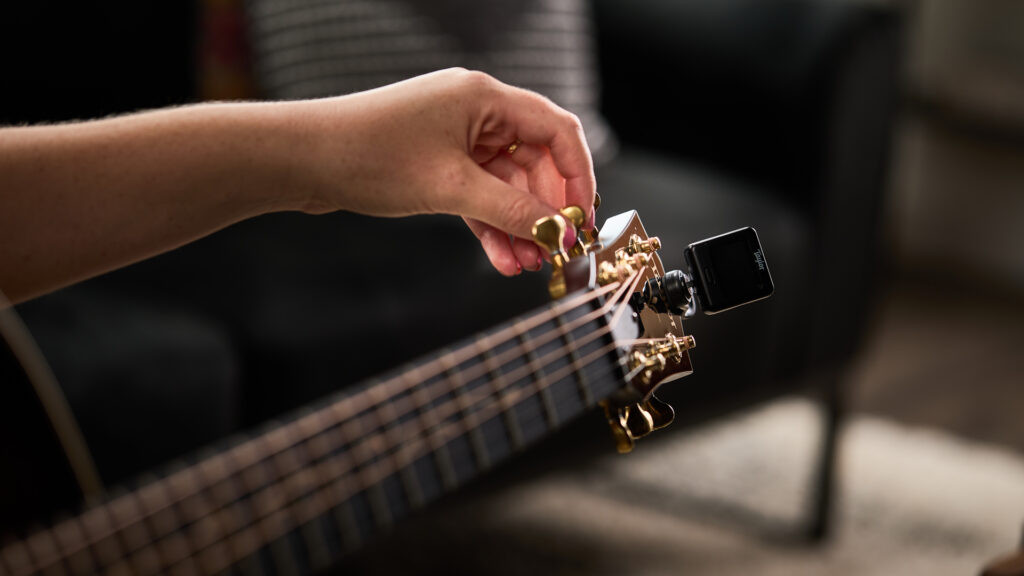 Guitar player stretching a guitar string to maintain tuning stability
Guitar player stretching a guitar string to maintain tuning stability
Staying In-Tune with Your Music
Initially, tuning might feel like a tedious chore, but it’s a fundamental skill that becomes second nature over time. Being in tune is crucial for sounding your best, whether you’re playing solo, with a band, or at an open mic night.
Remember, a quality instrument that is well-crafted and properly set up, like those from Taylor Guitars, will be inherently easier to tune and keep in tune. This allows you to spend less time tuning and more time enjoying the music.
Keep practicing your tuning skills, and soon you’ll be confidently tuning your acoustic guitar with a tuner and focusing on what truly matters – playing and creating music. Explore more beginner tips and guitar knowledge on guitarplayers.net to further your musical journey!

